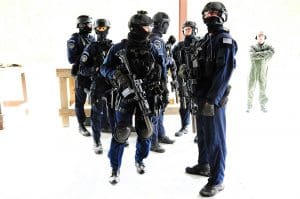TERRORISM RISK
Terrorism is defined by the FBI as “the unlawful use of force or violence against persons or property to intimidate or coerce a government, the civilian population, or any segment thereof, in furtherance of political or social objectives.” Reread that definition again and think about what it says.
Intimidate or coerce; meaning to frighten, threaten, scare, or force, bully, or pressure, and all in the furtherance of political or social objectives? Really? Isn’t that a part of our world every day? In some ways it is, so what should we do about it?
Governments around the world are working on this issue of terrorism and yet acts of terror still continue to plague the world.
Terrorism Threat Level
There is no way in which to determine where the next attack will come from in most cases because we are not dealing with a defined military, more so individuals or small groups that can operate undetected until they strike. So what can we as security professionals do to identify threats against our organizations, and/or implement protocols and processes to ensure the safety and security of our staff and customers/clients?
Identify Risks and Vulnerabilities
First we need to identify all security risks, vulnerabilities and threats that may affect our facilities, staff, and anyone that is present on our properties. In most cases this means that we will conduct a security risk assessment and measure our existing security against industry standards and best practices. However, keep in mind that unless you are aware of the current industry standards and best practices, and you are aware of all potential threats that may affect your business, you may not get a full picture of your actual security risks.
Once we have identified the risks and vulnerabilities, and we have taken the appropriate mitigation strategies, what else can we do?
Trained Security Professionals
Security officer training is critical in today’s world. Look at it this way, terror groups have publicized their intent to attack the police, military and security personnel across Europe and the United States. In response to that threat, what have you done to ensure that your security staff is trained on not only what to do, but also how to protect themselves against this threat?
For example, do you have only one security officer working per shift? If so, what is your protocol to check on them to insure that they are safe? Have your security officers received training in self defense, use of force (including the use of force continuum), observation skills, officer safety, and other important security skills?
Threat Assessment
The threats against our world change all the time, and therefore so must our approach to prepare for new threats and respond to the changing environments. In many cases our new threats are often classified as random acts which can be very difficult to predict and plan for.
Take for example the recent murder of two NYPD police officers, their assailant randomly chose them and attacked without provocation. The number of private security officers randomly attacked in the U.S. is also on the rise, and often attackers see very little difference between police and security. Therefore we must plan and prepare for potential “random acts” of violence like this.
Remember, the odds are small that this could happen at any given facility, but can you really afford to play the odds? Your organization may be at a higher risk than you think, so take the time now to review your security risks.





